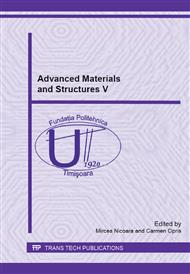[1]
Craig R., Powers J.M. Restorative dental materials, 11-th editon. Mosby International Ltd., (2002).
Google Scholar
[2]
Layton D. A critical appraisal of the survival and complication rates of tooth-supported allceramic and metal-ceramic fixed dental prostheses: the application of evidence-based dentistry. Int J Prosthodont. 2011 Sep-Oct; 24(5): 417-27.
Google Scholar
[3]
PH. DeHoff, Anusavice KJ, Hojjatie B., Thermal incompatibility analysis of metal-ceramic systems based on flexural displacement data. Journal of Biomedical Materials Research, 41: 614-23, (1998).
DOI: 10.1002/(sici)1097-4636(19980915)41:4<614::aid-jbm14>3.0.co;2-e
Google Scholar
[4]
S.I. Voicu, A. Dobrica, S. Sava, A. Ivan, L. Naftanaila, Cationic surfactants-controlled geometry and domensions of polymeric membrane pores, J Optoelectron Adv M 14 (11-12) (2012) 923-928.
Google Scholar
[5]
DH. Anthony, Burnett AP, Smith DL, Brooks MS. Shear test for measuring bonding în cast gold alloy-porcelain composites. Journal of Dental Research, 49: 27-33, (1990).
DOI: 10.1177/00220345700490012601
Google Scholar
[6]
KJ. Anusavice, Shen C, Hashinger D, Twiggs SW. Interactive effect of stress and temperature on creep of PMF alloys. J Dent Res, 64: 1094-9, (1985).
DOI: 10.1177/00220345850640081501
Google Scholar
[7]
CW. Fairhurst, Anusavice KJ, Hashinger DT, Ringle RD, Twiggs SW. Thermal expansion of dental alloys and porcelains. J Biomed Mat Res. 1980; 14: 435-46.
DOI: 10.1002/jbm.820140410
Google Scholar
[8]
TR. Walton, O'Brien WJ. Thermal stress failure of porcelain bonded to a palladium-silver alloy. J Dent Res. 64: 476-80, (1985).
DOI: 10.1177/00220345850640031801
Google Scholar
[9]
KJ. Anusavice, Dental casting and soldering alloys, Phillips Science of Dental materials. 11th ed. Philadelphia: Saunders; pp.563-620, (2003).
Google Scholar
[10]
KJ. Anusavice, DeHoff PH, Fairhurst CW, Comparative evaluation of ceramic-metal bond tests using finite element stress analysis. J Dent Res. 59: 608-13, (1980).
DOI: 10.1177/00220345800590030901
Google Scholar
[11]
JP. Coffey, KJ. Anusavice, PH. De Hoff, RB. Lee, Influence of contraction mismatch and cooling rate on flexural failure of PFM systems. J Dent Res. 67: 61-5, (1988).
DOI: 10.1177/00220345880670011201
Google Scholar
[12]
IA. Hammad, YF. Talic, Designs of bond strength tests for metal-ceramic complexes: review of the literature. J Prosthet Dent., 75: 602-8, (1996).
DOI: 10.1016/s0022-3913(96)90244-9
Google Scholar
[13]
G. Oilo, B. Johansson, M. Syverud, Bond strength of porcelain to dental alloys - an evaluation of two test methods. Scand J Dent Res. 89: 289-96, (1981).
DOI: 10.1111/j.1600-0722.1981.tb01685.x
Google Scholar
[14]
OL. Bezzon, MG. de Mattos, RF. Ribeiro, JM. Rollo, Effect of beryllium on the castability and resistance of metal-ceramic bonds în nickelchromium alloys. J Prosthet Dent., 80: 570-4, (1998).
DOI: 10.1016/s0022-3913(98)70034-4
Google Scholar
[15]
JR. Mackert, RD. Ringle, CW. Fairhurst, High-temperature behavior of a Pd-Ag alloy for porcelain. J Dent Res., 62: 1229-35, (1983).
DOI: 10.1177/00220345830620121201
Google Scholar


